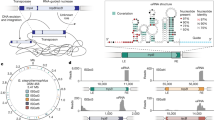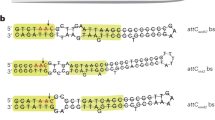Abstract
Insertion elements and transposons stimulate deletion formation, mediating the elimination of neighbouring host sequences at a high rate compared to the background of deletions occurring in their absence. The (non-lethal) deletions generated by a variety of transposable elements end at or near the terminus of the element1 (for reviews see refs 2–4). The finding that transposable elements generate the repetition of a short segment of host DNA on either side of the integrated element5,6 raises new questions about deletion formation at the sequence level. Do the deletions terminate at the precise endpoint of the element and remove the repeated sequence, or do they end within it or leave it intact? Is deletion formation linked to the transposition process? To study the above questions we have used the transposon Tn9, which carries the genetic determinants for chloramphenicol resistance flanked on either side by the insertion sequence IS17,8 (in the same orientation), and which like IS1 generates a nine base pair repeat upon integration5,6,9. Starting with a Tn9 integrated into the lacI gene of Escherichia coli, we examined deletions extending into the neighbouring lacZ and lacY genes. Sequence analysis, reported below, shows that after deletion formation the ends of the transposon remain intact, although one copy of the repeated 9 base pairs is removed by the deletion, fusing the end of Tn9 to host sequences several thousand base pairs away (in these cases). (Studies with Tn310, IS111 and IS212 are consistent with these results.) We also find that the Tn9-distal end of the deletions terminate preferentially within the same region of DNA in which Tn9 insertion points cluster, suggesting that the processes of deletion formation and transposition share a common pathway.
This is a preview of subscription content, access via your institution
Access options
Subscribe to this journal
Receive 51 print issues and online access
$199.00 per year
only $3.90 per issue
Buy this article
- Purchase on Springer Link
- Instant access to full article PDF
Prices may be subject to local taxes which are calculated during checkout
Similar content being viewed by others
References
Reif, H.-J. & Saedler, H. Molec. gen. Genet. 137, 17–28 (1975).
Starlinger, P. & Saedler, H. Curr. Topics Microbiol. Immun. 75, 111–152 (1976).
Kleckner, N. Cell 11, 11–23 (1977).
Bukhari, A., Shapiro, J. & Adhya, S. (eds) DNA Insertion Elements, Plasmids, and Episomes (Cold Spring Harbor Laboratory, New York, 1977).
Calos, M., Johnsrud, L. & Miller, J. H. Cell 13, 411–418 (1978).
Grindley, N. Cell 13, 419–426 (1978).
Gottesman, M. M. & Rosner, L. Proc. natn. Acad. Sci. U.S.A. 72, 5041–5045 (1975).
Mac Hattie, L. & Jackowski, J. in DNA Insertion Elements, Plasmids, & Episomes (eds Bukhari, A., Shapiro, J. & Adhya, S.) 219–228 (Cold Spring Harbor Laboratory, New York, 1977).
Johnsrud, L., Calos, M. & Miller, J. H. Cell 15, 1209–1219 (1978).
Ohtsubo, H., Ohmori, H. & Ohtsubo, E. Cold Spring Harb. Symp. quant. Biol. 43, 1269–1277 (1979).
Ohtsubo, H. & Ohtsubo, E. Proc. natn. Acad. Sci. U.S.A. 75, 615–619 (1978).
Peterson, P., Ghosal, D., Sommer, H. & Saedler, H. Molec. gen. Genet. 173, 15–21 (1979).
Hobson, A., Gho, D. & Müller–Hill, B. J. Bact. 131, 830–838 (1977).
Kleckner, N. Cell 16, 711–720 (1979).
Nisen, P., Kopecko, D., Chou, J. & Cohen, S. J. molec. Biol. 117, 975–998 (1977).
Weinstock, G. & Botstein, D. Cold Spring Harb. Syp. quant. Biol. 43, 1209–1215 (1979).
Noel, K. & Ames, G. Molec. gen. Genet. 166, 217–223 (1978).
Faelen, M. & Toussaint, A. J. Bact. 136, 477–483 (1978).
Grindley, N. & Sheratt, D. Cold Spring Harb. Symp. quant. Biol. 43, 1257–1261 (1979).
Shapiro, J. Proc. natn. Acad. Sci. U.S.A. 76, 1933–1937 (1979).
Nevers, P. & Saedler, H. Molec. gen. Genet. 160, 209–214 (1978).
Landy, A., Hoess, R., Bidwell, K. & Ross, W. Cold Spring Harb. Symp. quant. Biol. 43, 1089–1097 (1979).
Farabaugh, P. J., Schmeissner, U., Hofer, M. & Miller, J. H. J. molec. Biol. 126, 847–857 (1978).
Schmeissner, U., Ganem, D. & Miller, J. H. J. molec. Biol. 109, 303–326 (1977).
Miller, J. H. Experiments in Molecular Genetics (Cold Spring Harbor Laboratory, NewYork, 1972).
Maxam, A. & Gilbert, W. Proc. natn. Acad. Sci. U.S.A. 74, 560–564 (1977).
Fowler, A. & Zabin, I. J. biol. Chem. 253, 5521–5525 (1978).
Author information
Authors and Affiliations
Rights and permissions
About this article
Cite this article
Calos, M., Miller, J. Molecular consequences of deletion formation mediated by the transposon TN9. Nature 285, 38–41 (1980). https://doi.org/10.1038/285038a0
Received:
Accepted:
Issue Date:
DOI: https://doi.org/10.1038/285038a0
This article is cited by
-
The frequency of transposition of the maize element Activator is not affected by an adjacent deletion
Molecular and General Genetics MGG (1988)
-
Atypical deletions generated by mutated IS102 elements
Molecular and General Genetics MGG (1984)
Comments
By submitting a comment you agree to abide by our Terms and Community Guidelines. If you find something abusive or that does not comply with our terms or guidelines please flag it as inappropriate.



